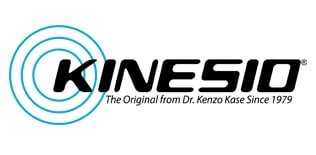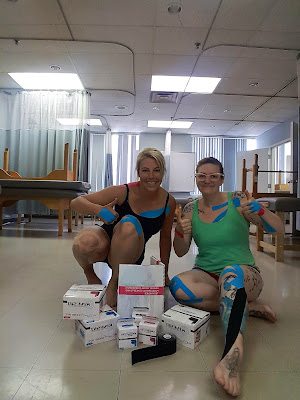Taping
What is it and how does it work?
Have you been at a sporting event or sitting at your desk and catch a glimpse of someone's bight coloured tape on their bodies and wonder 'what the heck is that for?' Well, we have the answer for you and now can tape you up at The Coach House!
 There are many different brands of kinesiology tape on the market with varying engineered makeup and purposes, yet our blog is about Kinesio Tex Tape.
There are many different brands of kinesiology tape on the market with varying engineered makeup and purposes, yet our blog is about Kinesio Tex Tape.
Megan and Krista went to the Kinesio Taping course in May to find out how it could benefit an array of clientele and how they could implement it into their Massage Therapy practices.
"We wanted to understand the mechanism behind the taping technique and try it, first hand, on clients to see how they could benefit from the lasting effects of the tape following their massage."
What is Kinesio Tape?
The tape comes in a variety of colours, yet the colours are for esthetic preference not differing strengths. The different effects come from the amount of tension your therapist applies to the tape and the direction the tape is applied in.
All the tape is 100% latex free, hypoallergenic, water-resistant and made of 100% cotton fiber strips. The tape is heat activated and made of acrylic adhesive. The fiber pattern is what gives the tape its unique ability along with being breathable and nonmotion restrictive.
Lymphatic Drainage/Edema
Muscle Tension
Muscle Imbalances
Stimulating weaker muscles to contract
Post-surgical conditions
Rehabilitation
Pain Management - Nerve and Muscle
Injury Prevention
How does it work?
The tape is a great treatment addition which helps the effects of massage set and the tape can last another 3-5 days after application. The gentle simulation will likely go unnoticed but has lasting benefits.
The tape assists with this by microscopically lifting the skin and fascia and therefore increasing the lymphatic and blood flow and stimulating the nervous system to the desired effect. The more tension the therapist applies to the tape the more simulation the muscles receive from the nervous system.
If the goal is to contract or stimulate the muscle the tape is applied from the origin of the muscle and with an increase of tension, applied to the tape, pulled to the insertion of the muscle. This creates a 'recoil' effect of the problematic muscle to help increase stimuli to contract the muscle.
On the contrary, if the goal is to relax the muscle we place the tight muscle into a lengthened position and with no tape tension, apply the tape from insertion toward the origin of the muscle. The tape will wrinkle which slightly lifts up the skin and creates a gentle stimuli telling the muscle to relax.
Our approach
We like individualizing the need and type of application for tape and if called for, adding it onto the end of a massage session. This way the muscles have been assessed and treated and the tape is an added take-home benefit when applied to overly tight muscles, weak muscles, acute injury, rehabilitation, and swelling. After an initial assessment taping can also be done in a 15-minute appointment.
We have successfully been using Kinesio Tex Tape in treatments for
- Muscle Tension
- Postural Pain
- Injury Prevention
- Athletic Support
Depending on your individual needs and treatment goals we can customize the tape job that is right for you. For more information or to find out of taping is right for you, ask Megan or Krista at your next appointment! We are happy to find a method that works best for you.




No comments:
Post a Comment